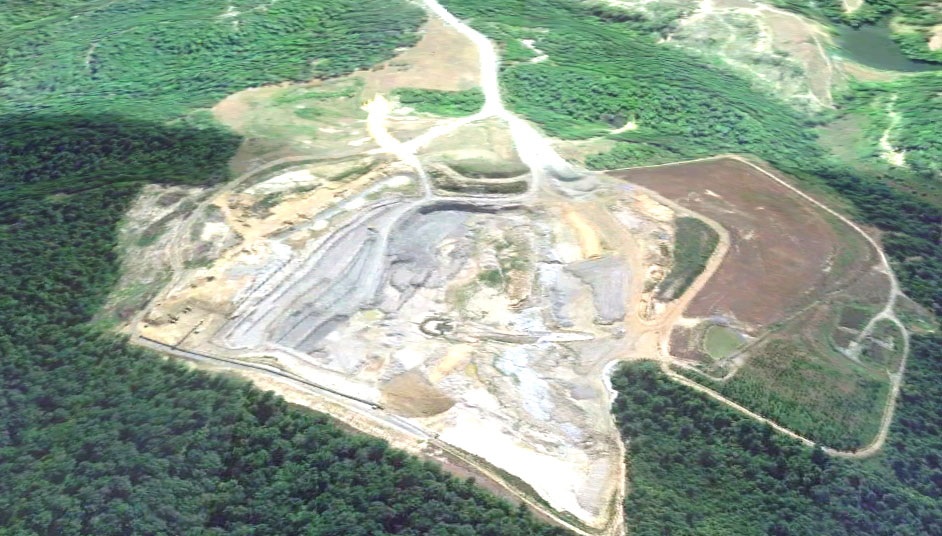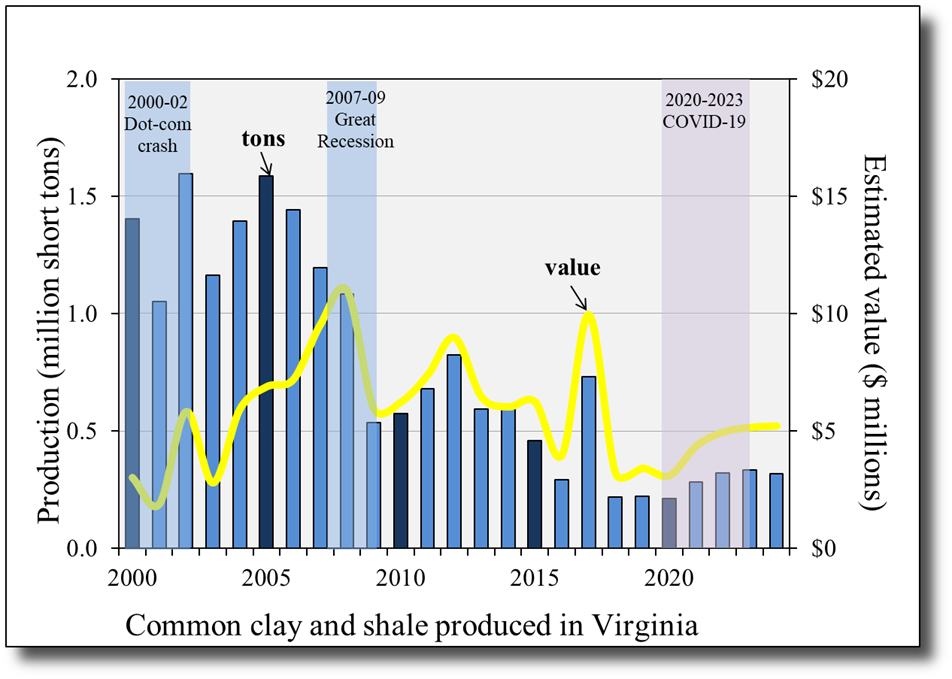Clay is a term used interchangeably to denote a class of very-fine grained sediments, or alternatively a loosely-defined group of hydrous aluminum-silicate minerals. Clay sediments are the fine-grained earthy material that results from natural chemical weathering and hydrothermal rock alteration. Clay sediments are often characterized by high plasticity, or workability, that is useful for the manufacture of structural clay products such as brick and tile as well as pottery. Shale is a fine-grained sedimentary rock formed by the consolidation of clay and silt size particles.
Clay deposits commonly consist of fine-crystalline or amorphous minerals including kaolinite (Al2Si2O5(OH)4), illite ((H3O,K)y(Al4•Fe4•Mg4•Mg6)(Si8-yAly)O20(OH)4), and montmorillonite, ((Na,Ca)0.3Al2Si4O10(OH)2-nH20). These minerals belong to the clay mineral group distinguished by a layered crystal lattice structure that allows for the exchange of calcium, sodium, potassium, among other ions. This property makes certain clay minerals useful in industrial applications for adsorption, filtration, oil refining, and as additives in paint and paper manufacture.
In Virginia, common clay and shale is mined to produce bricks, tile, pottery, cement, lightweight aggregate, and road bed material. Frequently used as a building material or construction aggregate, the market and price are often comparable to other natural aggregates such as sand and gravel. The costs of transporting construction aggregates from the mine source to the end user are a major factor controlling the marketable geographic range, which is typically within a 25 to 30 mile radius of the mine site. It is imperative that high quality construction-grade resources are carefully managed and conserved for the future as part of informed land use decision-making.
Number of mines producing common clay and shale in Virginia: 36
Number of counties in Virginia with mines: 19
Number of operators: 30
Quantity produced in 2024: 319 thousand short tons
Estimated market value in 2024: $5.2 million

In Virginia, a diatomaceous montmorillonite clay known as fuller's earth is mined by two companies operating mines in King and Queen County and King William County. The material is sold primarily as cat litter, but is also marketed as an animal feed supplement, and as a highly absorbent material for cleaning oil and chemical spills. Extraction of the fuller's earth is by dragline. These deposits occur in the Tertiary-age Calvert Formation. Due to the more specialized industrial applications of fuller's earth compared to common clay and shale, the market is more competitive and the unit price can be substantially higher.

Nestle Purina, King William County
Number of mines producing fuller's earth in Virginia: 1
Number of counties in Virginia with mines: 1
Number of operators: 1
Quantity produced in 2024: 381 thousand short tons
Estimated market value in 2024 : $31.1 million

Common clay and shale production and value in Virginia1
1 Estimates of annual mineral value are calculated using tonnages reported to Virginia Energy and commodity sales prices reported in numerous published and unpublished sources. The prices may include national or global industry averages. The calculated annual values do not necessarily reflect the actual sales prices received by mine operators in Virginia.
Selected References:
Calver, J.L., Hamlin, H.P., and Wood, R.S., 1961, Analyses of clay, shale, and related materials -- northern counties: Virginia Division of Mineral Resources Mineral Resources Report 002, 194 p.
Calver, J.L., Smith, C.E., and Le Van, D.C., 1964, Analyses of clay, shale, and related materials -- west-central counties: Virginia Division of Mineral Resources Mineral Resources Report 005, 230 p.
Johnson, S.S., Denny, M.V., and Le Van, D.C., 1966, Analyses of clay, shale, and related materials - southwestern counties: Virginia Division of Mineral Resources Mineral Resources Report 006, 186 p.
Johnson, S.S., and Tyrell, M.E., 1967, Analysis of clay and related materials - eastern counties: Virginia Division of Mineral Resources Mineral Resources Report 008, 232 p.
Ries, H., 1906, The clay deposits of the Virginia Coastal Plain: Virginia Geological Survey Bulletin 2, 184 p.
Ries, H., and Somers, R.E., 1917, The clays of the Piedmont province, Virginia: Virginia Geological Survey Bulletin 13, 86 p.
Ries, H., and Somers, R.E., 1920, The clays and shales of Virginia west of the Blue Ridge: Virginia Geological Survey Bulletin 20, 118 p.
Sweet, P.C., 1973, Analyses of clay, shale, and related materials -- southern counties: Virginia Division of Mineral Resources Mineral Resources Report 012, 183 p.
Sweet, P.C., 1976, Clay-material resources in Virginia: Virginia Division of Mineral Resources Mineral Resources Report 013, 56 p.
Sweet, P.C., 1982, Virginia clay material resources: Virginia Division of Mineral Resources Publication 036, 178 p.
Sweet, P.C., 1986, Clay-material samples collected 1981-1984: Virginia Division of Mineral Resources Publication 068, 107 p.
Sweet, P.C., 1988, Clay material testing program, 1957-1986: Virginia Division of Mineral Resources Publication 076, 46 p.
Upchurch, M.L., 1998, The Cold Spring and related clay deposits along the western slope of the central Blue Ridge in Virginia: Virginia Division of Mineral Resources Virginia Minerals, Vol. 44, No. 1, p. 1-7.
U.S. Geological Survey, 2020, Clays Statistics and Information
Wood, R.S., 1962, Structural clay products industry: Virginia Division of Mineral Resources Virginia Minerals, Vol. 8, No. 2, p. 1-7.
